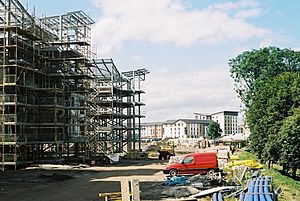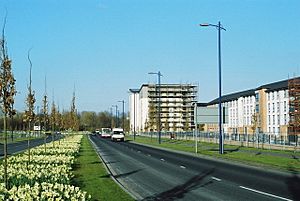Oatlands, Glasgow facts for kids
Quick facts for kids Oatlands |
|
|---|---|
 New apartments on Haughview Terrace |
|
| Population | 1,827 (2018) |
| Council area | |
| Lieutenancy area |
|
| Country | Scotland |
| Sovereign state | United Kingdom |
| Post town | GLASGOW |
| Postcode district | G5 |
| Dialling code | 0141 |
| Ambulance | Scottish |
| EU Parliament | Scotland |
| UK Parliament |
|
| Scottish Parliament | |
Oatlands is a neighbourhood in the city of Glasgow, Scotland. It is located south of the River Clyde. This area is part of the historic Gorbals region.
Oatlands is connected to Glasgow Green park by the Polmadie Bridge. This bridge was taken down in 2015 because it was not safe. A new bridge was built in its place in 2018.
Contents
A Look Back: How Oatlands Changed
Until the 1990s, Oatlands had many old buildings. These included four-storey red sandstone apartments built around 1900. There were also three-storey grey stone apartments from the 1930s. These older homes were sometimes called Rehousing buildings.
A large urban park called Richmond Park opened in 1899. It had a boating pond and was named after Sir David Richmond. He was a important leader in Glasgow at the time. Many apartment buildings faced this park across a busy road.
Old Buildings and Schools
Oatlands used to have a small cinema and a church. The church was designed by John Honeyman. It was first called Buchanan Memorial Church. Later, it became St Bonaventure's RC Church.
Schools were also nearby. John Bosco Secondary School was extended in the 1970s. Woseley Street Primary School was also in the area. There was even a local "steamie," which was a public washhouse. By the mid-1990s, most of these old buildings were removed.
Richmond Park School was built for children with physical disabilities. It was on the site of the old Woseley Street School. In 2009, this school joined with another one. Later, in 2010, the Hampden School buildings were damaged. So, students from Hampden School moved into the Richmond Park site. The Oatlands building was then renamed Hampden School. It is now the only school in the area.
Building a New Community
After many old buildings were taken down, work began in 2005. The goal was to create a new neighbourhood. This plan included building about 1,510 new homes. Most of these homes (81%) were for private owners. The rest (19%) were for social rent.
This project won awards. Glasgow City Council led the way. Bett Homes (now Avant Homes) was the main builder. Other groups like Link and Glasgow Housing Association also helped. By 2007, many new homes were built. A new road, called the Boulevard, was also created.
The project slowed down due to a big economic downturn around 2007. However, a walkway along the River Clyde was reopened in 2011. Also, the M74 motorway was extended. This new motorway has a junction that serves Oatlands.
Some land in the area was cleared for the motorway. This included an old football ground called Rosebery Park. There were some safety concerns during this work. This was because of chemicals in the ground from an old factory nearby. These chemicals sometimes made the water in Richmond Park turn strange colours.
By 2014, over 500 new homes were finished. Plans were approved for 378 more private houses. New apartments were built around Oatlands Square. This name was used in the area's old maps. Public art was also added. A steel sculpture called 'Oatlands Girl' was unveiled in 2016. It shows parts of the area's history.
Two new garden areas were created for growing plants. The Oatlands Development Trust also built a new play area. This was the first step in a big plan to improve Richmond Park.
The main road, Rutherglen Road, was moved. This helped connect the new homes with Richmond Park. Future plans for Oatlands include a community centre and shops. The project is mostly paid for by Avant Homes.
The rebuilding project had some challenges. For many years, new building was stopped due to safety risks. Over 750 old apartments were taken down. At first, there were ideas for a business park. But the community wanted homes. The new design of Oatlands came from many community meetings. Even though some architects have different ideas, the new Oatlands is becoming a popular place to live in Glasgow.
Notable People from Oatlands
- Jimmy Boyle, an artist
- James Dornan, a politician
- David Holt, a footballer who played for Queen's Park and Hearts
- Eddie Large, a comedian, born Edward McGinnis
- Frank McLintock, a football player and expert, who played for Arsenal
- Alex Wright, a footballer and manager



